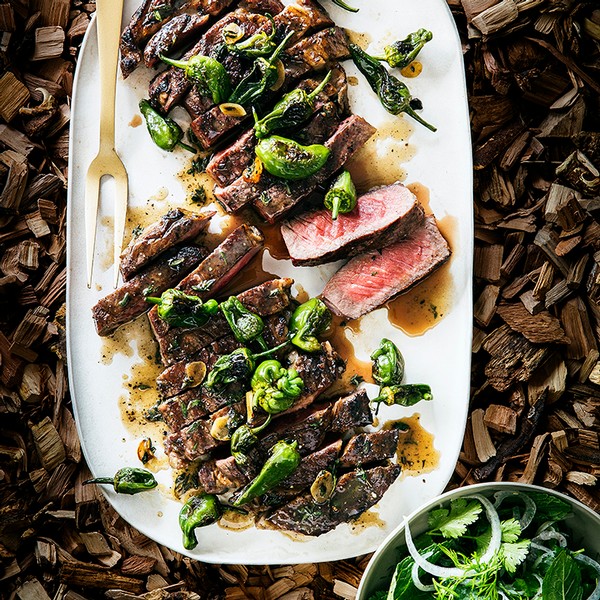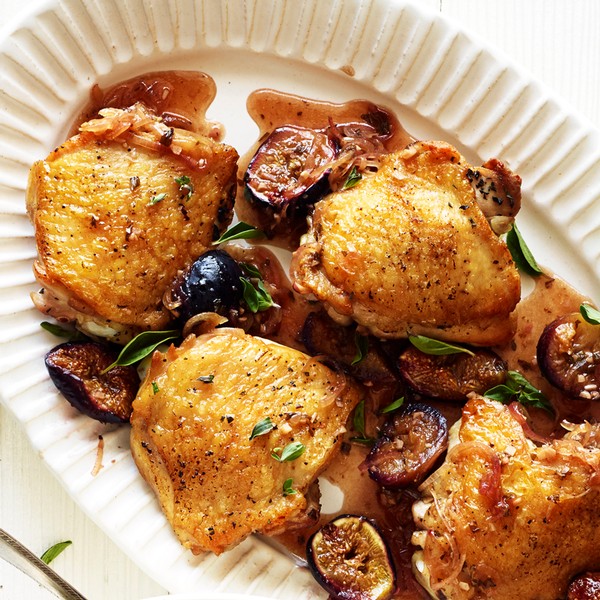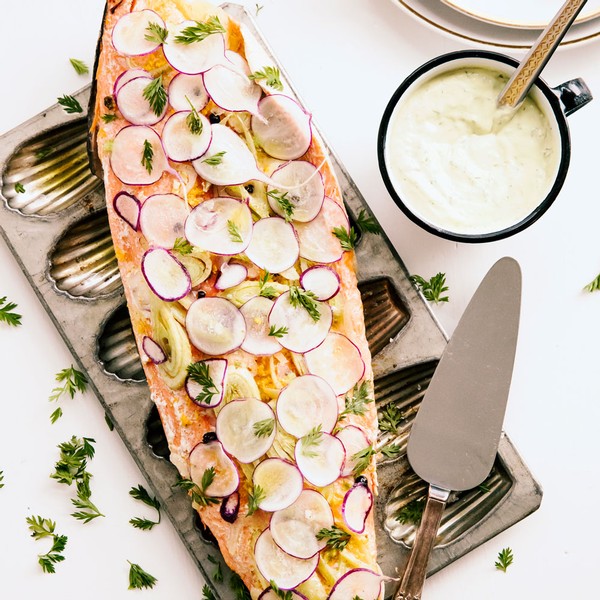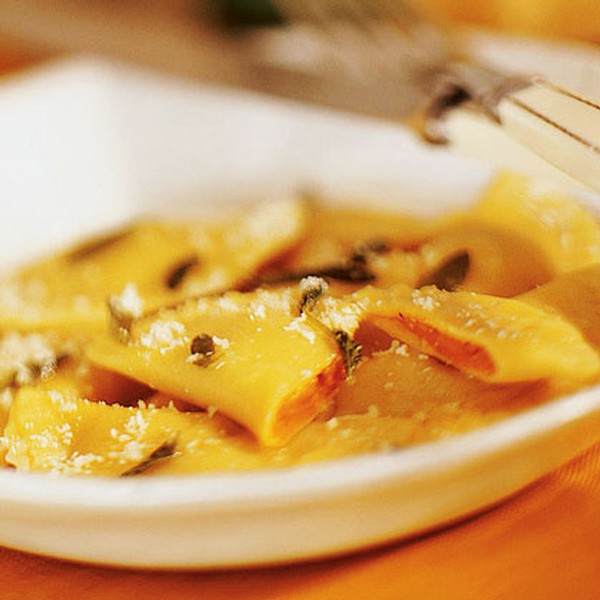2019 Chardonnay & Pumpkin-filled Pasta
Fall 2022 selections: Pumpkin-filled Pasta
Whether you folllow this recipe to make the homemade pasta or choose to substitute for gyoza wrappers, the delicate sweet and savory flavors of pumpkin wrap around the citrus, stone fruit, and mineral flavors of our 2019 Chardonnay.
Ingredients:
Filling
1 cup canned pumpkin (about half of a 15-oz. can)
2 tablespoons finely chopped Cremona fruit in mustard syrup (optional)
1/4 cup fresh-grated parmesan cheese
2 tablespoons finely crushed amaretti or other almond macaroon cookies
1 tablespoon fine dried bread crumbs
1/8 teaspoon fresh-grated nutmeg
1/4 teaspoon salt
1 tablespoon brandy
Pasta:
About 2 cups unbleached or regular all-purpose flour
1/4 teaspoon salt
3 large eggs
2 large egg yolks
Substitute: Japanese gyoza wrappers
Sauce:
1/2 cup (1/4 lb.) butter or margarine
1/3 cup lightly packed fresh sage leaves, rinsed and dried
1/2 cup fresh-grated parmesan cheese
Salt and pepper
Instructions:
1. To make filling: In a bowl, mix pumpkin, Cremona fruit in mustard syrup, parmesan cheese, crushed amaretti cookies, bread crumbs, nutmeg, salt, and brandy.
2. To make pasta: In a food processor, whirl 2 cups flour and salt to blend; add eggs and egg yolks, and whirl until dough holds together (or in a bowl, mix ingredients with a fork). Scrape pasta dough onto a lightly floured board and roll to coat with flour. Knead until dough feels smooth, adding flour as required to prevent sticking, about 1 minute if mixed in a food processor, 15 minutes if stirred. Cover dough with plastic wrap and let rest 10 to 15 minutes.
3. Divide dough in half and shape each portion into a smooth ball. Roll each ball through a pasta machine to 1/16 inch thick, or roll on a floured board. With a floured 2 3/4-inch round cutter, cut out 48 to 50 pasta rounds. Reroll dough as needed; discard excess.
4. Spoon an equal portion of filling onto center of each pasta round (about 1 teaspoon). Moisten pasta rims with water, fold over to enclose filling, and press edges with fork tines to seal. Arrange filled pasta on a floured surface (or 10- by 15-in. baking pans, if making ahead); let dry 10 minutes, turn over, and dry 20 minutes longer (or cover airtight and chill).
5. Bring 4 quarts water to a boil in a 7- to 8-quart pan over high heat; add half the pasta and cook, stirring occasionally, until tender to bite, 8 to 10 minutes. As they are cooked, transfer with a slotted spoon to a rimmed ovenproof platter; cover with foil and keep warm on an electric warming tray or in a 250° oven. Repeat to cook remaining pasta.
6. To make sauce: In an 8- to 10-inch nonstick frying pan over high heat, melt butter. Add sage leaves and stir often until darker green, about 30 seconds. Immediately, pour over the filled pasta, sprinkle with 1/2 cup parmesan cheese, and add salt and pepper to taste.
Why It Works
The richness of the pumpkin and savory herbal notes of the sage are a great match for our 2019 Chardonnay. The body is of good weight to pair with the pasta, and savory notes are accentuated by stony minerality and hazelnut notes. The ripe fruit dances with the subtle sweetness of the pumpkin for a gorgeous harmony of flavor.
2017 Pinotage & Grilled Rib-Eye with Blistered Padrón Peppers
Fall 2022 selections: Grilled Rib-Eye with Blistered Padrón Peppers
Take advantage of the last bit of warm weather this September by opening up the grill. This recipe recommends using a smoker to infuse fruit flavors into the rib-eye, a perfect match to our 2017 Pinotage.

Recipe by Matthew Dillon via Sunset Magazine
Ingredients:
2 beef rib-eye steaks, each 16 oz. and 1 1/4 to 1 1/2 in. thick, preferably well-marbled, grass-fed, and dry-aged
2 tablespoons grapeseed oil, divided
2 1/4 teaspoons kosher salt, divided
About 1 1/4 tsp. pepper, divided
1/4 cup butter, divided, softened
2 tablespoons fresh thyme leaves, divided
2 tablespoons honey, divided
2 tablespoons cider vinegar, divided
2 cups (5 oz.) Padrón or shishito peppers
2 garlic cloves, thinly sliced
Instructions:
1. An hour before cooking, season steaks with 2 tsp. salt and 1 tsp. pepper and set on a plate to come to room temperature. Then, brush steaks with 1 tbsp. oil. Meanwhile, soak 1 cup fruitwood chips in a bowl of water about 30 minutes.
2. Put 2 tbsp. butter in a shallow baking dish big enough to hold steaks. Add a few cracks of pepper and 1 tbsp. each thyme, honey, and vinegar; bring to grill area. Bring ingredients for peppers to grill: the Padróns; remaining 1 tbsp. oil, 1/4 tsp. salt, and 2 tbsp. butter; a dish with remaining 1 tbsp. thyme and the garlic; and another dish with remaining 1 tbsp. each honey and vinegar. Also bring a large cast-iron skillet, wooden spoon, grilling tongs, and foil.
3. For charcoal, ignite a very full chimney of hardwood mesquite charcoal on firegrate of a charcoal grill. Arrange coals on firegrate in a slope so there's a hotter area and a cooler one. Drain wood chips and scatter over charcoal. Set cooking grate in place. For gas, heat a gas grill to high (450° to 550°). Put drained wood chips in the grill's smoking box, or seal chips in a packet of foil, cut dime-size holes, and set directly on a burner. Cover grill.
4. When wood chips start to smoke (1 to 2 minutes for charcoal, 10 to 15 minutes for gas), set steaks over hottest part of charcoal fire (or anywhere on gas grill). Grill steaks covered, turning once and moving to cooler part of charcoal fire if they start to flare up, until well browned and done the way you like, about 10 minutes for medium-rare. Transfer steaks to baking dish with butter mixture, turn to coat, and tent loosely with foil.
5. Heat cast-iron skillet on cooking grate. When hot, add 1 tbsp. oil and swirl to coat. Then add peppers and 1/4 tsp. salt. Cook, shaking skillet and stirring occasionally, until peppers are browned and blistered, about 5 minutes. Add butter and let it foam and brown, 45 to 60 seconds. Stir in thyme, garlic, and honey-vinegar, then pour mixture over steaks. Let steaks rest about 1 minute more.
6. Transfer steaks to a cutting board, leaving juices and peppers in baking dish. Slice steaks crosswise into 1/2- to 3/4-in. strips. Using a spatula, pick up strips in original shape of steaks and set on a platter. Spoon about half of juices and peppers over steaks and serve the rest in a bowl on the side.
Why It Works
With its savory, leathery characteristics, our 2017 Pinotage is made for red meat off the grill. Its bold plum and blueberry notes mingle with the smoked, fruity character of the rib-eye, while firm tannins, cedar, peppercorn, and herbal spicy character are enlivened by the blistered padróns.
Fall 2022 Releases & Food Pairings
As the weather cools down, embrace the sweet & savory sides of fresh produce and herbs in season.
2020 Bicentennial Chardonnay & Poached Orange-Fennel Salmon with Dill Crème
In this recipe, fennel and dill harmonize to evoke a toasty beginning of fall. The roundess of the poached salmon & crème is offset by the fresh citrus and spice of the radish, matching the body of our 2020 Bicentennial Chardonnay.
2019 Stagecoach Road Pinot Noir with Chicken & Roasted Figs
This simple roasted chicken thighs recipe is great for any night of the week. A touch of sweetness from honey and carmelized figs accentures the ripe fruit of our 2019 Stagecoach Road Pinot Noir for a meal that will keep you warm on a chilly fall evening.
2017 Pinotage & Grilled Rib-Eye with Blistered Padrón Peppers
Take advantage of the last bit of warm weather this September by opening up the grill. This recipe recommends using a smoker to infuse fruit flavors into the rib-eye, a perfect match to our 2017 Pinotage.
2019 Stagecoach Road Pinot Noir with Chicken and Roasted Figs
Fall 2022 selections: Chicken and Roasted Figs
This simple roasted chicken thighs recipe is great for any night of the week. A touch of sweetness from honey and carmelized figs accentures the ripe fruit of our 2019 Stagecoach Road Pinot Noir for a meal that will keep you warm on a chilly fall evening.

Recipe by Adeena Sussman via Sunset Magazine
Ingredients:
2 tablespoons good-quality (cask-aged) red wine vinegar
1 teaspoon cornstarch
1/4 cup honey
2 pounds (4 to 6) bone-in, skin-on chicken thighs
1 teaspoon kosher salt, divided
3/4 teaspoon pepper, divided
2 tablespoons olive oil
3 large shallots, thinly sliced
6 garlic cloves, chopped
2 tablespoons chopped fresh oregano leaves, plus 2 tbsp. whole leaves
8 to 10 figs, stems trimmed, halved (quartered if large)
Instructions:
1. Preheat oven to 400°. In a small bowl, whisk together 1/4 cup water, the vinegar, and cornstarch. Whisk in honey and set aside. Sprinkle chicken on both sides with 3/4 tsp. salt and 1/2 tsp. pepper.
2. Heat a heavy 12- to 14-in. ovenproof frying pan over medium-high heat until hot. Add oil and swirl to coat, then add chicken skin side down and brown until skin is deep golden and crisp, 8 to 10 minutes. Turn over and brown other side, 2 to 3 minutes more. Transfer chicken to a plate and set aside.
3. Discard all but 2 tbsp. fat from frying pan, reduce heat to medium, and cook shallots until translucent, 3 to 5 minutes. Add garlic and cook 1 minute more. Add cornstarch mixture, chopped oregano, and remaining 1/4 tsp. each salt and pepper; cook until mixture bubbles and thickens, 1 to 2 minutes.
4. Set chicken skin side up in frying pan and add figs. Roast in oven until figs soften and caramelize slightly and meat is no longer pink at bone, about 15 minutes. Divide chicken, figs, and sauce among plates and top with whole oregano leaves.
Why It Works
Our 2019 Stagecoach Road Pinot Noir is on the fuller-bodied side of the spectrum for Pinot Noir, giving it enough tannin and body to stand up to the richness of dark-meat chicken thighs. With its ripe black fruit and underpinning of herbal notes, it mingles well with the sweet-and-savory flavors of the roasted chicken and figs.
2020 Bicentennial Chardonnay & Poached Orange-Fennel Salmon with Dill Crème
Fall 2022 selections: Poached Orange-Fennel Salmon with Dill Crème
In this recipe, fennel and dill harmonize to evoke a toasty beginning of fall. The roundess of the poached salmon & crème is offset by the fresh citrus and spice of the radish, matching the body of our 2020 Bicentennial Chardonnay.

Recipe by Kristen Murray via Sunset Magazine
Ingredients:
1 king salmon fillet with skin (2 to 2 1/2 lbs. and about 1 in. thick; cut from tail end), pin bones removed*
Zest and juice of 1 large orange
1 small shallot, thinly sliced crosswise, separated into rings
1 small, tender fennel bulb, trimmed and very thinly sliced on a diagonal, a few feathery leaves reserved (or use torn carrot tops)
1/4 to 1/2 cup dry white vermouth, such as Dolin
2 tablespoons extra-virgin olive oil, divided
About 1 tsp. flake sea salt, such as Maldon, divided
1 teaspoon white pepper
1 teaspoon ground coriander
5 juniper berries, crushed with fingers
Paper-thin radish slices (2 or 3 radishes)
Dill Crème
1/4 teaspoon coriander seeds
1 large ripe avocado, pitted and peeled
2 tablespoons lemon juice
2 tablespoons roasted hazelnut oil*
2 tablespoons dry white vermouth such as Dolin
1 cup crème fraîche
About 1 tsp. flake sea salt such as Maldon
3 tablespoons finely chopped fresh dill
Instructions:
1. Preheat oven to 325°.
2. Prepare the dill crème:
2a. Pulse coriander in a food processor to break up. Add remaining ingredients except for salt and dill; whirl until smooth. Season to taste with salt. Scrape sauce into a bowl and fold in dill.
3. Cut a sheet of 18-in.-wide heavy-duty foil three times as long as salmon and center it on a rimmed baking sheet, letting ends hang over. Set salmon, skin side down, on foil. Sprinkle fish evenly with orange zest, shallot, and fennel bulb. Bring corners and sides of foil up around salmon to make a canoe with 2-in. sides.
4. Pour orange juice into a glass measuring cup and add vermouth to make 3/4 cup. Microwave until steaming (about 170°) and pour evenly over fish. Drizzle with 1 tbsp. oil and sprinkle evenly with 1/2 tsp. salt, the pepper, coriander, and juniper berries. Tightly roll ends and sides of foil together to create a pouch.
5. Bake salmon until cooked through three-quarters of the way from edge to center of thickest part (which will still look wet; open foil and cut fish to check), 12 to 25 minutes, depending on thickness.
6. Slide two long metal spatulas under fish and carefully transfer to a long platter (Murray likes to use a madeleine pan), leaving poaching liquid behind. Sprinkle radishes, about 1/2 tsp. salt, and remaining 1 tbsp. oil over fish. Scatter torn fennel fronds on top. Serve with Dill Crème
Why It Works
As noted above, the body of our 2020 Bicentennial Chardonnay is just right for the weight of this dish. The oak signature is light on this Chardonnay, and therefore the purity of the fruit flavors mingle with the orange while the minerality complements the green spices of the dish.
